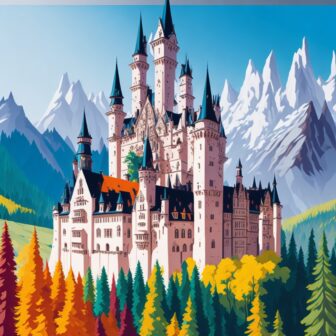14 Most Beautiful Monasteries in Germany (2023)
These are the 14 most beautiful monasteries in Germany. They have been an important part of the German cultural and economic landscape for many centuries. Even if there are not many anymore, monks and nuns live in monasteries in Germany and have completely focused their lives on God.
For many people, they are not only popular travel destinations in Germany, but also places of retreat and relaxation.
You can not only visit the monasteries in Germany and learn more about their exciting history, but also spend a holiday in the monastery. Completely isolated from the media and the need to always be available.
I show you the most beautiful monasteries in Germany. Many are still inhabited as monasteries today, others have lost their function and serve a different purpose.
Many monasteries in Germany were dissolved in the course of the Reformation or around 1800.
You can still find most of them in the south of Germany, especially in Bavaria and Baden-Württemberg. I recommend you to visit at least one of these beautiful monasteries on your next trip.
Abbey of St. Hildegard, Hesse
Idyllically located in the middle of vineyards you will find the Abbey of St. Hildegard in Rüdesheim am Rhein.
The monastery was founded in 1904 and donated by Prince Karl zu Löwenstein-Wertheim-Rosenberg.
It was rebuilt in neo-Romanesque style and has a beautifully designed abbey church.
The monastery is the successor to the Rupertsberg and Eibingen monasteries founded by St. Hildegard von Bingen.
You can see the monastery and visit the monastery church during the day. You can also stay overnight as guests in the monastery or take part in one of the courses offered.
The monastery is maintained by marketing and selling the wine from its own winery. The monastery also has a restoration workshop, ceramics workshop and goldsmith.
In the monastery café you can stop off and enjoy a piece of cake while exploring the hiking trails through the vineyards.
Maria Laach Abbey, Rhineland-Palatinate
The monastery complex of the Maria Laach Abbey rises majestically over the Laacher See in the Eifel. The Benedictine monastery was founded between 1093 and 1216.
Not only can you visit the monastery in one day, but you can also spend the night in a guest wing and take part in services and talk to the nuns and monks.
A special highlight is the large library of the Maria Laach Abbey. It comprises around 260,000 titles, around 9,000 of which were printed before 1800. This makes it one of the largest private libraries in Germany.
The monastery is also a small commercial enterprise. It leases a piece of land to an organic farm, has a monastery nursery, a publishing house, a book and art shop and other economic pillars.
You can also take a trip to one of the most beautiful lakes in Germany, the Laacher See, from here.
Plankstetten Monastery, Bavaria
The next on our list of most beautiful monasteries in Germany is in Bavaria and is also inhabited by Benedictine monks.
The monastery was founded in 1129 and beer has been brewed and sold in the abbey since the 15th century.
Today the monastery is a small commercial enterprise with its own butcher’s, gardening, distillery, bakery, farm shop, restaurant and beekeeping. Many of the products are certified organic products.
The monastery church, which combines elements from the Baroque, Gothic and Rococo periods, is particularly beautiful.
Maulbronn Monastery, Baden-Württemberg
The Maulbronn Monastery is located between Heilbronn and Pforzheim. The monastery complex is the best preserved medieval monastery complex north of the Alps.
In the course of the Reformation and the subsequent historical upheavals, the monastery was temporarily abandoned and occasionally inhabited by monks.
Today, the Maulbronn Monastery, which is located in the center of Maulbronn, houses the police, several restaurants, the town hall, several administrative offices and a Protestant grammar school with a boarding school.
You can visit the monastery today as part of a guided tour and learn more about the history of the building.
Special highlights are the vestibule of the monastery church in the early Gothic style and the fountain house with its three-bowl fountain.
You can combine a trip to the Maulbronn Monastery with a visit to the Bad Schönborn thermal baths. It is one of the best thermal baths in Germany.
Archabbey of Beuron, Baden-Württemberg
You will find this impressive monastery complex in a picturesque location on the Danube, only about an hour’s drive from Lake Constance.
Since 1863 the Archabbey has been run as a Benedictine monastery.
Before that, the monastery was an Augustinian monastery from the second half of the 11th century until 1803.
The complex includes an impressively equipped monastery and pilgrimage church in the Baroque style.
It is characterized by its many ornate ceiling paintings from the Beuron art school.
This arose from a group of artists who came together in 1868 in the Abbey for the renewal of Catholic ecclesiastical art.
Their role models were above all the Egyptian, early Christian and Byzantine arts.
The Archabbey of Beuron offers accommodation and seminars for guests.
You can browse in the monastery bookstore or buy fruit brandies and herbal schnapps from our own distillery. The monastery also offers teas and cosmetic products.
Ottobeuren Monastery, Bavaria
Since 764 you can find the Ottobeuren monastery between Kaufbeuren and Memmingen in Upper Swabia. Today the monastery is inhabited by around 19 Benedictine monks.
Particularly impressive is the Basilica of St. Alexander and St. Theodore, which was built between 1737 and 1766 as a monastery church.
The interior of the church includes magnificent dome and ceiling frescoes, altarpieces and stucco work. You can view the architecture of the monastery as a total work of art.
The other rooms of the monastery such as the Kaisersaal testify to the beauty of the Baroque.
The library of the Ottobeuren monastery is also worth seeing. Here you will find many medieval manuscripts, hundreds of incunabula and early prints.
In the Ottobeuren monastery you can look at the history and art objects of the monastery in the museum, you can also strengthen yourself in the monastery café or book a guided tour through the rooms of the monastery.
Blieskastel Monastery, Saarland
Blieskalstel Monastery has been a popular place of pilgrimage for believers since the 17th century
They are attracted by the 14th-century Vespers painting “Our Lady with the Arrows”. This is kept in the Holy Cross Chapel, which was built in 1682.
The Arrow Madonna is said to have healing powers.
Since the chapel could soon no longer hold the influx of pilgrims, a larger monastery church was inaugurated in 1925.
Since 2005, the Blieskastel Monastery has been looked after and inhabited by Franciscan Friars Minor.
Loccum Monastery, Lower Saxony
Located between the Weser and Steinhuder Meer, Loccum Abbey awaits you. It was founded in 1163 as a Cistercian monastery and, like Maulbronn Monastery, is considered to be the best-preserved Cistercian monastery north of the Alps.
After the monastery no longer belonged to the Catholic Church, the new seminary for 12 candidates was established here at the beginning of the 19th century.
The German pilgrimage route Loccum-Volkenroda connects it to the monastery of Volkenroda in Thuringia.
Today the monastery is looked after by the Evangelical-Lutheran Church of Hanover and is used as a preacher’s seminary, conference center and excursion destination.
The monastery church was probably built in the years 1230/40 to 1280 and thus belongs to the oldest construction period of the monastery complex.
RELATED:
Best Places to Visit in Hanover
Best Hotels in Hanover
Neresheim Abbey, Baden-Württemberg
Another monastery in Baden-Württemberg that we don’t want to withhold from you is Neresheim Abbey.
It was founded in 1095 and converted into a Benedictine abbey in 1106. The abbey church, built in 1750, is considered the spiritual and architectural center of the monastery complex and is one of the most popular sights in all of Baden-Württemberg.
The church is decorated with a large number of impressive frescoes. These were created by Martin Knoller and are among the most important frescoes of the late Baroque period. The interior of the church otherwise shines in bright white.
The main organ dates from the years 1794 to 1797 and has largely been preserved in its original condition to this day.
Today you can spend the night in the monastery hospice and enjoy the peace and quiet of the monastery.
Visit the monastery museum and learn more about Nersheim Abbey. You can buy products from our own production in the monastery shop or browse through the monastery bookshop.
You can also have the monastery shown to you as part of a guided tour.
Lehnin Monastery, Brandenburg
From 1180 to 1542, the Lehnin monastery existed as a Cistercian abbey in the town of Lehnin.
Today it is used as a facility of the evangelical church.
You can vacation there, stay overnight during your pilgrimage or visit the museum.
It is also used as a conference venue for various events.
The monastery church is a late Romanesque-early Gothic brick church. The interior of the church is quite simple, unlike most Catholic churches.
During a guided tour of the monastery grounds you can learn more about the history of the individual buildings and their architecture.
Blaubeuren Monastery, Baden-Wuerttemberg
The Blaubeuren monastery is located right next to the natural wonder of Blautopf. From 1085 until the Reformation, the monastery was the residence and place of work of Benedictine monks.
After that it became a Protestant seminary and is now used as a classical language grammar school. Pupils from the 9th to 12th grade live here in the boarding school.
Visit the monastery church from the 15th century and marvel at the choir stalls and the high altar, both of which date back to the Middle Ages and were created by artists and sculptors from the Ulm School.
You can get to know the monastery grounds as part of a guided tour. A highlight is the historic bathhouse of the monks.
Lorsch Monastery, Hesse
Embark on an exciting journey through time and visit the Lorsch Monastery between Worms and Bensheim on your next holiday in Germany.
From 764 to 1564 it was an important monastery and spiritual center.
When the Pope donated a relic, the number of pilgrims suddenly increased and the monastery was able to continue to expand.
In the course of the Reformation, the Lorsch Monastery was finally dissolved by the Elector Palatinate.
Important manuscripts were created in the monastery. For example the Lorsch Codex, the Lorsch Gospels and the Lorsch Bee Blessing.
Today the monastery complex is a UNESCO World Heritage Site.
The monastery’s portico is one of the few complete surviving monuments from the Carolingian period.
A display depot is housed in the tithe barn, where you can admire excavated objects from the 2nd and 3rd centuries.
Carolingian columns and other finds from the heyday of the monastery are also on display.
In the museum center on the site you will also find a tobacco museum and a monastery history department.
A planted herb garden takes up the history of the Lorsch pharmacopoeia. This dates from the end of the 8th century and marks the beginning of medicine in the western world.
St Trudpert, Baden-Württemberg
The monastery of St. Trudpert is located near Freiburg im Breisgau. Today it is run by the Congregation of the Sisters of Saint Joseph.
The traces of the monastery of St. Trudpert can be traced back to the year 600. From the 9th century until its secularization in 1806 it was operated as a Benedictine monastery. From 1919 the first Sisters of Saint Joseph moved into the convent.
You can visit the beautifully situated monastery in the Münstertal or stay there as a guest.
You can also try out the monastery for a while and get to know the daily routine in a monastery.
The Benedictine abbey had a large treasury with a significant amount of gold.
Some of the pieces are now on display at the Hermitage Museum in Russia and the Metropolitan Museum of Art in New York.
Drubeck Monastery, Saxony-Anhalt
The former Benedictine monastery in Ilsenburg (Harz) is now a conference center of the Evangelical Church in Central Germany.
It is used as a pedagogical-theological institute and has a house of silence and a pastoral college as well as a media center.
The nunnery was first mentioned in 960. The monastery life survived the turmoil of the Reformation with a short interruption and was then continued until 1946 as a Protestant women’s monastery.
After that it became a convalescent home and from 1996 the current facilities moved into the complex.
You can also spend the night in the former monastery and use the seclusion of the facility to relax or explore the area on a hiking tour.
Would you like to get to know more hiking regions? Here I show you the national parks in Germany.
14 Most Beautiful Monasteries in Germany (2023)
- Abbey of St. Hildegard, Hesse
- Maria Laach Abbey, Rhineland-Palatinate
- Plankstetten Monastery, Bavaria
- Maulbronn Monastery, Baden-Württember
- Archabbey of Beuron, Baden-Württemberg
- Ottobeuren Monastery, Bavaria
- Blieskastel Monastery, Saarland
- Loccum Monastery, Lower Saxony
- Neresheim Abbey, Baden-Württemberg
- Lehnin Monastery, Brandenburg
- Blaubeuren Monastery, Baden-Wuerttemberg
- Lorsch Monastery, Hesse
- St Trudpert, Baden-Württemberg
- Drubeck Monastery, Saxony-Anhalt






